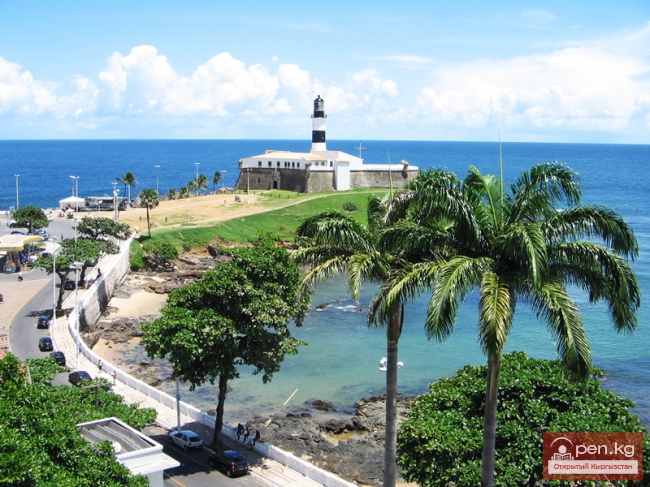SLOVENIA. Republic of Slovenia
A state in the southern center of Europe, in the northwestern part of the Balkan Peninsula. Area - 20.3 thousand km².
Coastline (Adriatic Sea) - 46.6 km. Capital - Ljubljana (267 thousand), major cities: Maribor, Celje, Kranj. Administrative-territorial division - 62 districts. Population - 1.99 million (2002); Slovenes make up 90%; Croats - 3%, Serbs - 2%, Hungarians - 0.5%, Italians - 0.4%. Half of the population lives in cities.
Official language - Slovenian (in areas where Italian and Hungarian communities reside - also Italian and Hungarian languages). Religion: 70% of Slovenes practice Catholicism, 0.7% - Islam (classified as the ethnic group "Muslims"). Currency - tolar.
Diplomatic relations with the Russian Federation were established on May 25, 1992.
National holiday - June 25 - Day of Statehood (1991).
According to the constitution adopted on December 23, 1991, Slovenia is a parliamentary republic. The head of state is the president (Janez Drnovšek, elected on December 1, 2002, for a term of 5 years, non-partisan). The president represents the country abroad, is the supreme commander of the armed forces, appoints elections to the National Assembly, submits laws for approval to the National Assembly, and proposes a candidate for prime minister.
The Parliament of Slovenia - the National Assembly, consists of 90 deputies elected for 4 years (the last elections were held in the fall of 2004). 88 of them are elected in nationwide elections from electoral districts through universal, equal, direct, and secret voting based on a proportional election system with a 4% threshold for entering the parliament; 2 deputies representing the Hungarian and Italian national minorities are elected by representatives of these national minorities. There is also a National Council (comprising 40 deputies elected for 5 years representing social, economic, professional, and local interests) - an advisory body with the right of suspensive veto.
The highest executive power in the country belongs to the government, which, while being independent within its competence, is accountable to the National Assembly. The current coalition government, formed on December 23, 2004, is headed by Janez Janša - the leader of the Slovenian Democratic Party (SDP). In addition to the SDP, the government includes representatives of the Christian People's Party "New Slovenia" (NS; leader - Andrej Bajuk), the Slovenian People's Party (SNP; leader - Jožef Podobnik), and the Democratic Party of Pensioners of Slovenia (DPPSS; leader - Anton Rous). After the elections on December 3, 2004, the SDP has 29 seats in the National Assembly, the Liberal Democracy of Slovenia has 23, the United List of Social Democrats has 10, NS has 9, SNP has 7, the National Party of Slovenia has 6, DPPSS has 4, and there is one representative from the Hungarian and Italian minorities.
Trade union associations: Association of Free Trade Unions of Slovenia and Independence - Confederation of New Trade Unions of Slovenia.
The territory of present-day Slovenia was settled by Slavs in the 6th century. In the 11th and 13th centuries, a number of feudal principalities were formed there - Carinthia, Styria, Carniola, and others. From the early 16th century, almost the entire territory of Slovenia was under the control of Austria. In the 19th century, the national liberation movement began. After World War I and the collapse of Austria-Hungary, Slovenia became part of the Kingdom of Serbs, Croats, and Slovenes (from 1929 - the Kingdom of Yugoslavia). In 1941, Slovenia was occupied by fascist Germany and was subjected to dismemberment. It was liberated during the National Liberation War of 1941-45 in Yugoslavia. From 1945 to 1991, it was part of the Federal People's Republic of Yugoslavia (then the Socialist Federal Republic of Yugoslavia - SFRY) as one of its 6 republics.
In April 1990, multi-party elections were held. On December 26, 1990, based on the results of the referendum (December 23), Slovenia was declared an independent state. On June 25, 1991, the assembly of the republic adopted the Declaration of Independence and Sovereignty of the country. On October 8, 1991, the assembly proclaimed the state independence of Slovenia and announced its withdrawal from the SFRY. In 1992, it was admitted to the UN and OSCE, and in 1993 - to the Council of Europe. In April 2004, Slovenia became a member of NATO, and in May of the same year - a member of the EU.
In terms of economic development, Slovenia ranked first in the SFRY in 1991: it accounted for 21.3% of the total Yugoslav gross national product. Despite the economic downturn in the country after the collapse of the SFRY, partly due to the loss of up to 40% of markets for Slovenian goods in the territory of the former Yugoslavia, Slovenia managed to normalize the situation in the national economy. GDP amounts to 24 billion euros (10 thousand euros per capita).
The main industries: machine engineering, ferrous metallurgy, electrical engineering, automotive industry. Shipbuilding, chemical, rubber, woodworking, paper, leather and footwear, food, and tobacco industries are also well developed. Slovenia operates the Krško Nuclear Power Plant (producing 4 billion kWh of electricity per year).
Slovenia has a highly productive agricultural sector. Its main branches are livestock farming for meat and dairy production, grain production, horticulture, and viticulture. Broiler poultry farming is widely developed. A significant portion of agricultural and industrial products is exported. The total volume of foreign trade is 17.6 billion euros. More than 80% of Slovenian exports go to EU countries.
The main foreign trade partners of Slovenia are Germany, Italy, France, Austria, Croatia, Russia, and the USA. The country exports machinery, automotive, and textile products, which together account for 70% of the country's exports, as well as chemical industry products (8.2%), agricultural products (5.1%), and others.
Daily newspapers: "Delo," "Dnevnik," "Večer," "Slovenske novice."
The information agency is the Slovenian Press Agency - STA. Broadcasting on radio and television is conducted in Slovenian, Hungarian, and Italian (3 state radio stations and 2 state television channels).











































